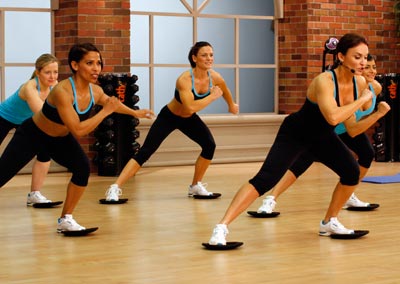
You want to get the most out of your workouts and you really love high-intensity routines, but your joints no longer can handle the jumping and high impact exercises. Many of you have probably tried some low impact workouts but found the intensity and fun to be lacking in most of the videos you have tried. You still have the heart and the strength for high-intensity workouts and you would still do them if you could, but joint pain no longer allows you to do what you love.
Some of you may not have any joint issues now but are looking for ways to balance your injury risk so that you don’t erase your hard-fought gains achieved from high impact training. There are many factors to consider when choosing between high impact and low impact exercise, but what if you could get the benefit of both in the same workout without the problems?
The Differences between High Impact and Low Impact Exercise
High impact exercise is when both feet come off the ground at the same time. Good examples of high impact exercises are jumping jacks, jumping rope, running or jogging on a treadmill (or outdoors), and performing plyometric exercises. High impact activities also include exercise classes which involve jumping, leaping or jogging in place. Doing high impact exercise puts you at greater risk of injury, especially if you’re just starting out.
Comparatively, low impact exercise is when one foot is on the ground at all times. Walking is a great example and also one of the most popular forms of low impact activity. Unlike running or jogging, when you walk, you always have one foot touching the ground. Other examples of low impact exercise are working out on an elliptical machine, cycling, swimming, low impact aerobics and using a rowing machine. It’s important to realize that low impact doesn’t mean low intensity ( unless purposely designed to be so) because you can still get an intense workout keeping both feet on the ground.
What Are the Advantages and Disadvantages of Each Type of Exercise?
Both high-impact and low impact workouts have their advantages and disadvantages. One of the best advantages of high impact workouts is the benefit it has for bone health. High impact exercise helps to increase bone mineral density more than low impact exercise does. This means high-impact is better for preventing osteoporosis. High impact activities also usually allow you to raise your heart rate faster. This is a great advantage if you don’t want to spend a lot of time exercising.

Low impact workouts are ideal if you are overweight, have joint problems or injuries that may be aggravated by running or jumping. This is because low impact exercises like walking or cycling place significantly less force on the body than high impact workouts like running or plyometrics. Low impact activities are also ideal for someone new to working out. The less jarring exercises are kinder to the unconditioned frame of a beginner.
While there is no true physical disadvantage to participating in a low impact workout, one might argue that it doesn’t seem as easy to burn the same amount of calories during the same time period doing a low impact activity as it does working out for the same amount of time doing a high impact activity. My answer to that is “a little creativity can go a long way, wink”.
Can my Low Impact Series be as effective as a high-intensity workout? The Slide and Glide Solution!
Usually, people equate low impact cardio as being much easier than high impact cardio and furthermore think of low impact workouts as beginner only workouts.
Cardiovascular exercise, simply known as “cardio”, refers to exercise that pushes the heart rate to at least half of a person’s maximum heart rate (MHR). Cardio exercise has two main levels that people talk about: low impact and high impact. These levels are determined by the amount of effort put into the exercise and the resulting increase in your heartbeat as well as other factors. Historically, low impact cardio aims for a pulse rate of 50-55% of your MHR. High impact cardio is usually defined as driving the heartbeat to 75-85% of your MHR. You may also hear the middle ground of 55% to 75% referred to as moderate impact cardio.
Some people use the terms “low-intensity cardio” and ” low impact cardio” interchangeably. The term “high-intensity cardio” and “high impact cardio” also get interchanged the same way. However, it is important to point out that the terms “intensity” vs “impact” are quite different. “Intensity” is your body’s perceived effort of exertion while “impact” is the effect of the exercise on your joints and muscles. That distinction is an important point. Exercise that drives your heart rate into the high-intensity range doesn’t necessarily have to be hard on your joints and muscles. A very strenuous workout in a pool doesn’t put as much strain on the body as a hard run, but it may still push your heart rate into the upper high-intensity range. The reverse is also true. You can keep your heart rate in the low range for cardio exercise and still inflict a beating on your knees.
In designing my new series of low impact workouts I was finding it difficult to get the heart rate and intensity where I needed it to be and to still keep the fun factor in the
Can You Have High Intensity and Low Impact Cardio in The Same Workout?
According to many professionals maybe not, but according to my new Low Impact Series…absolutely!
As I mentioned earlier, most professionals’ define low impact cardio as a workout that raises your heart rate to only 50-55% of your MHR which is not very high. However, with my new Low Impact Series, that’s all about to change.
As far as I’m concerned, a low impact cardio routine is certainly one in which there is no jumping and one foot stays on the ground at all times, but the heart doesn’t necessarily have to be less than a high impact cardio workout. Though it may not always be possible to make a low impact cardio routine as hard as a high impact cardio workout, with some creativity you can come pretty close. My new Low Impact Series redefines low impact cardio and is truly one of the first home exercise series to combine low impact with high intensity.
Does Low Impact Mean the Same as Joint-friendly? A look into my new Low Impact Series “JFT premixes™”!
Almost any low impact exercise will certainly be less stressful to your joints than a high impact exercise, but some low impact exercises may still be too stressful for many people to do, i.e. lunges and squats. This is why my new Low Impact series will feature a revolutionary new type of premix in many of the workouts that will help people who have problems with certain exercises to have a more joint-friendly workout.
Some of the Low Impact Series premixes will feature the same workout as the main workout but will have a more joint-friendly exercise substituted for a movement, like a forward lunge, that puts less stress on the joint and makes the exercise more comfortable to do. We call these new premixes “JFT Premixes™” and those of you that have knee and joint issues will really like these.
Joint-Friendly Premixes™ is a new way of making a fitness DVD that will allow you to minimize the stress you place on your joints and still get almost the same high-intensity workout as a person without a joint issue. Even if you have certain training limitations due to joint pain, in most cases you will be able to work around your joint issues with our new JFT Premixes™ and still get a great high-intensity workout.
Related Articles By Cathe:
Low Impact Series: Joint-Friendly Training Tips and Alternatives to Squats and Lunges
Cathe Discusses Her Inspiration for Developing The Low Impact Series

